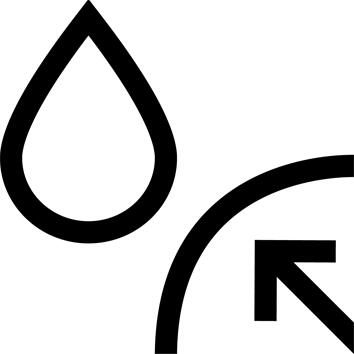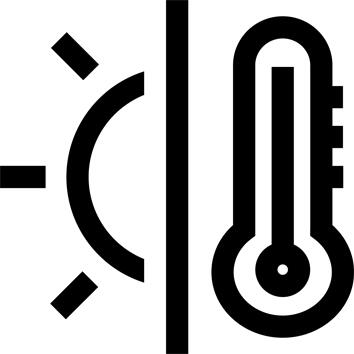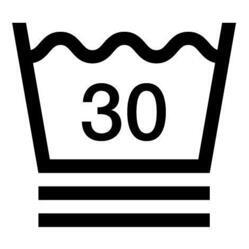Which filling will keep my jacket warm?
Known for their high thermal insulation, down and feathers also offer an excellent weight/warmth/compression ratio. However, it's important to remember that warmth comes from the combination of down/feather weight and the loft of the jacket. (50% down and 50% feather filling on the body, 100g/m² recycled wadding on the bottom of the jacket and arms, 60g/m² on the collar).
Which components added to the filling keep you warm?
Waterproof zips, a snow skirt, collar, adjustable hood and adjustable cuffs complement your jacket's padding to further insulate you from the cold, for a warmer feel.
How is the comfort temperature measured?
We test each of our products in the laboratory to give you an indicative comfort value. This is measured without tights for pants, and with a thermal T-shirt and fleece for jackets. The measurement indicated is that of the outside temperature at which the testers felt neither hot nor cold. This feeling differs, of course, according to the intensity of the activity, but also according to each individual's metabolism.
How should you dress to stay warm on the slopes?
To stay warm and dry, simply apply the 3-layer rule:
- Layer 1 or second skin, to stay dry.
- Layer 2 or insulating layer, to retain heat.
- Layer 3 or protective layer, to protect from the elements.
How is waterproofness measured?
We measure a fabric's resistance to water pressure expressed in mm water column (test based on ISO 811). The higher the pressure, the more waterproof the fabric. This component, with a waterproof rating of 10000mm, is therefore able to withstand the pressure exerted by 10000mm of water.
For skiing, we recommend components ranging from 3000mm to 20000mm.
In addition, at Decathlon, we test all our waterproof products in the laboratory. The rating for this product is 3/5
What is a membrane and what is it used for?
The membrane is a very thin component applied to the inside of the jacket's outer fabric. Hydrophilic, it blocks water coming from the outside and also evacuates perspiration produced by the body from the inside. To stay warm and dry, the membrane is a must.
What parts of the jacket protect me from the elements?
The 500 jacket has been developed with a rigorous component and assembly design that blocks the passage of water and limits the sensation of wind, to help you cope with the elements (rain, snow, wind, etc.). To validate its waterproofness, this jacket was placed under a special shower reproducing the conditions a skier would encounter. We validated the waterproofness of this product in practice over several days in different weather conditions.
What is the purpose of water-repellent jackets?
A fabric's water repellency is its ability to let water slide off its surface, without absorbing it. This jacket is equipped with water-repellent components that prolong its resistance to the elements. Water repellency is achieved by a treatment applied to the outer face of the fabric, but in use these properties can be altered.
How do you reactivate the water repellency of your jacket?
It's important to remember that water repellency can be reactivated. To do this, you can use a waterproof spray can (sold in our stores): spray the product evenly all over the garment, then leave to dry for 10 to 12 hours.)
What does a "breathable" jacket mean?
It's a product that lets the water vapor produced by your body during exercise escape. To determine whether a fabric is breathable, its evaporative resistance (RET) is measured in an ISO 11092 standard test. The lower the RET value, the more breathable the fabric. The 500 jacket has a RET of 11. However, it's the technical solutions (zips, vents, mesh) used by Wedze that limit condensation inside the garment and maximize breathability.
What is the cut of the 500 jacket?
Regular fit. The sides of the jacket fall straight and remain parallel, without trying to follow the shape of your bust. The interior volume allows this jacket to be worn with a first and second technical layer.
How do you prevent snow from falling in?
The snow skirt (which is automatic) and adjustable sleeve cuffs prevent snow and air from entering during practice, especially in the event of a fall.
How do I wash my jacket?
* Close all down jacket zips
* Turn the down jacket inside out
* Machine wash at 30°, on a gentle program with little detergent and no fabric softener.
IMPORTANT: set the spin speed to very gentle (less than 800 rpm): spinning too hard may create feather balls that are difficult to remove
* Add 2 clean, ideally white, tennis balls to the washing machine drum.
* A second or third rinse to remove any remaining detergent from the previous wash.
How do I dry my jacket?
Tumble-dry (highly recommended)
* Gentle or delicate program.
* Use several long cycles to dry thoroughly.
* Between 2 cycles, pat the down to separate the feather balls that have formed in the wash.
If you don't have a tumble-dryer, the process takes longer (drying can take 1 to 2 weeks in a dry, flat place). Be sure to pat the jacket to avoid featherballs (at least 4/5 times).
Where do the feathers come from?
Our traceability system enables us to guarantee the origin of the feathers, in line with our commitment to responsible materials. Our suppliers are committed to using only feathers from ducks raised for their meat and plucked after slaughter.
http://developpement-durable.decathlon.com/faq/
This product is repairable
During the warranty period, we will repair your product free of charge. Whether it's snags, seams, zips,... These solutions will be offered to you in your usual store. If, however, we are unable to repair your product (production defect), you can exchange it or have it refunded.
To help you choose the right size
The model in the photo wears size M and measures 185 cm.
Her measurements are :
Chest: 104 cm
Waist: 104 cm
Arm length: 45 cm
Inseam height: 80 cm















